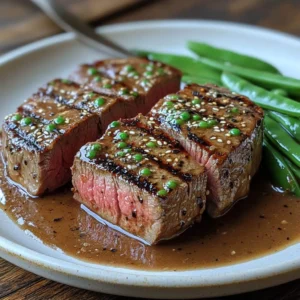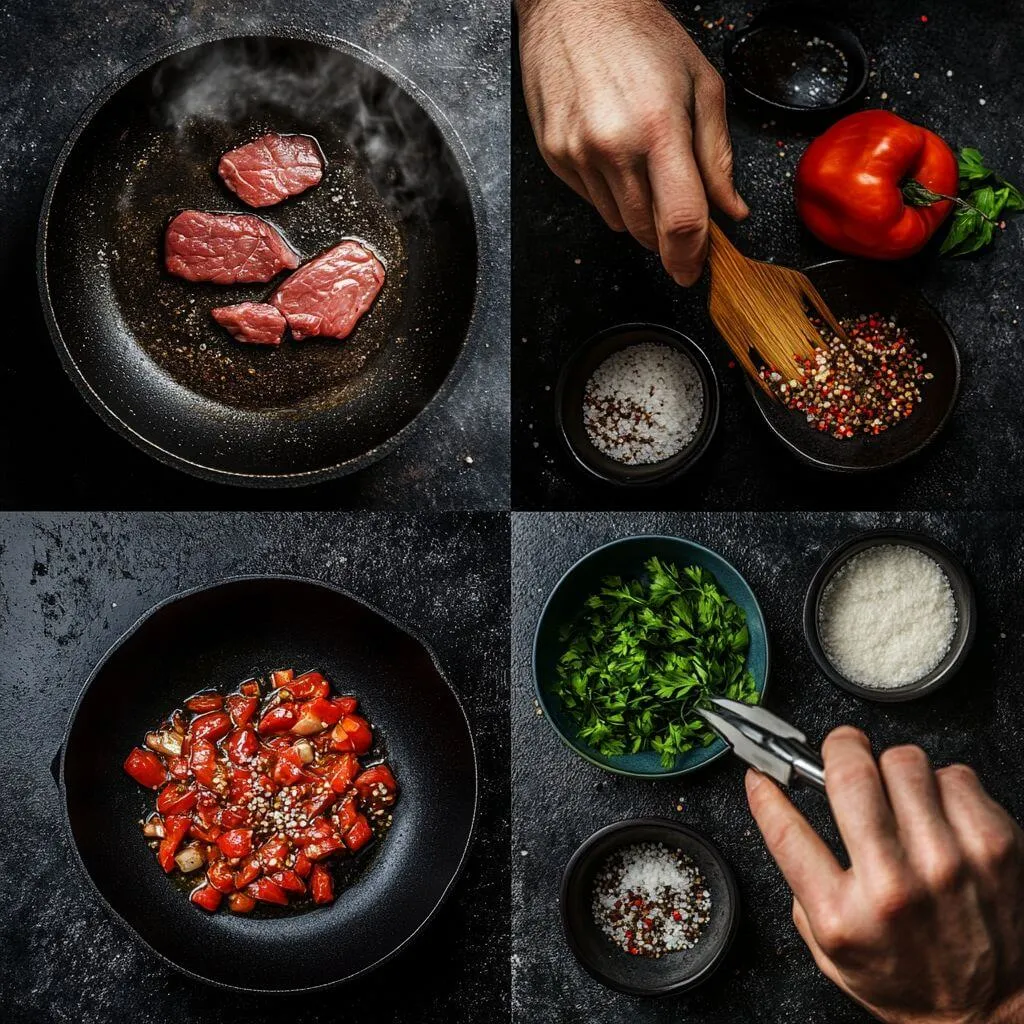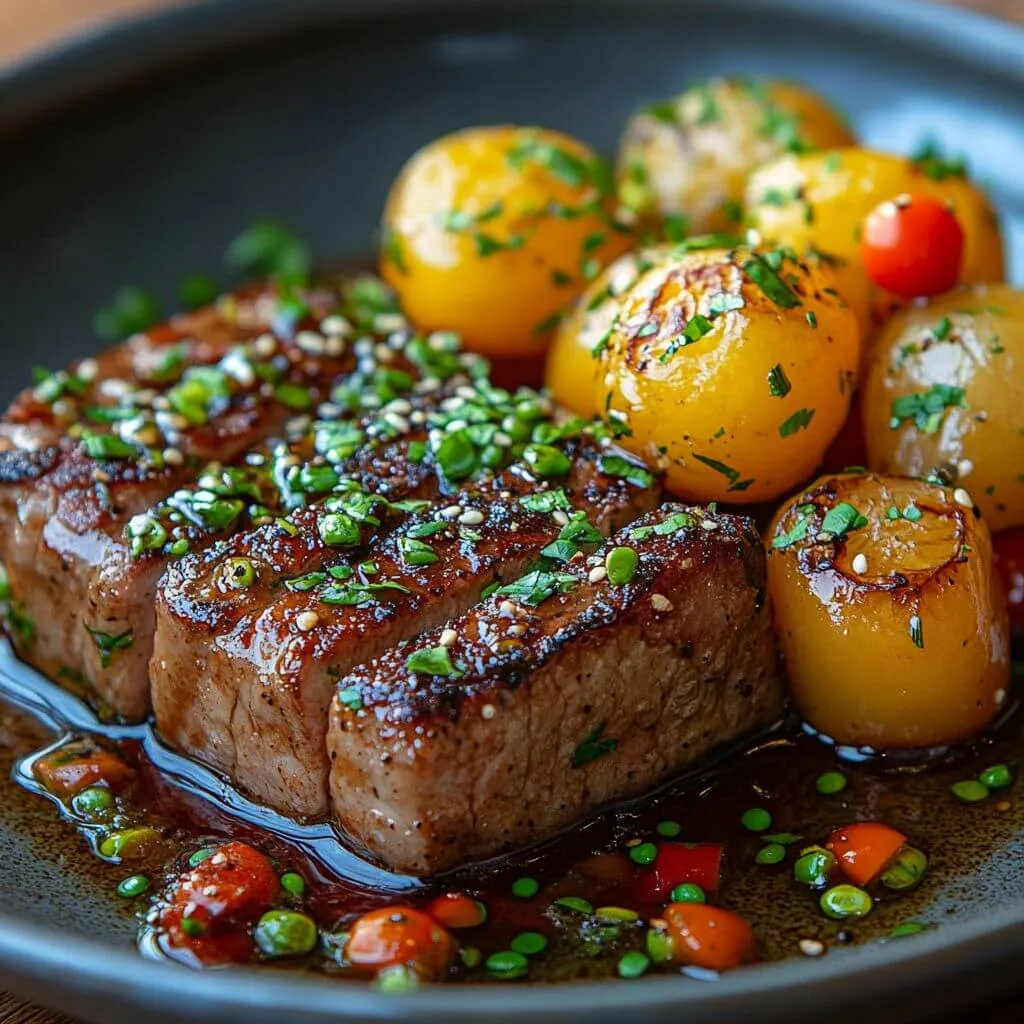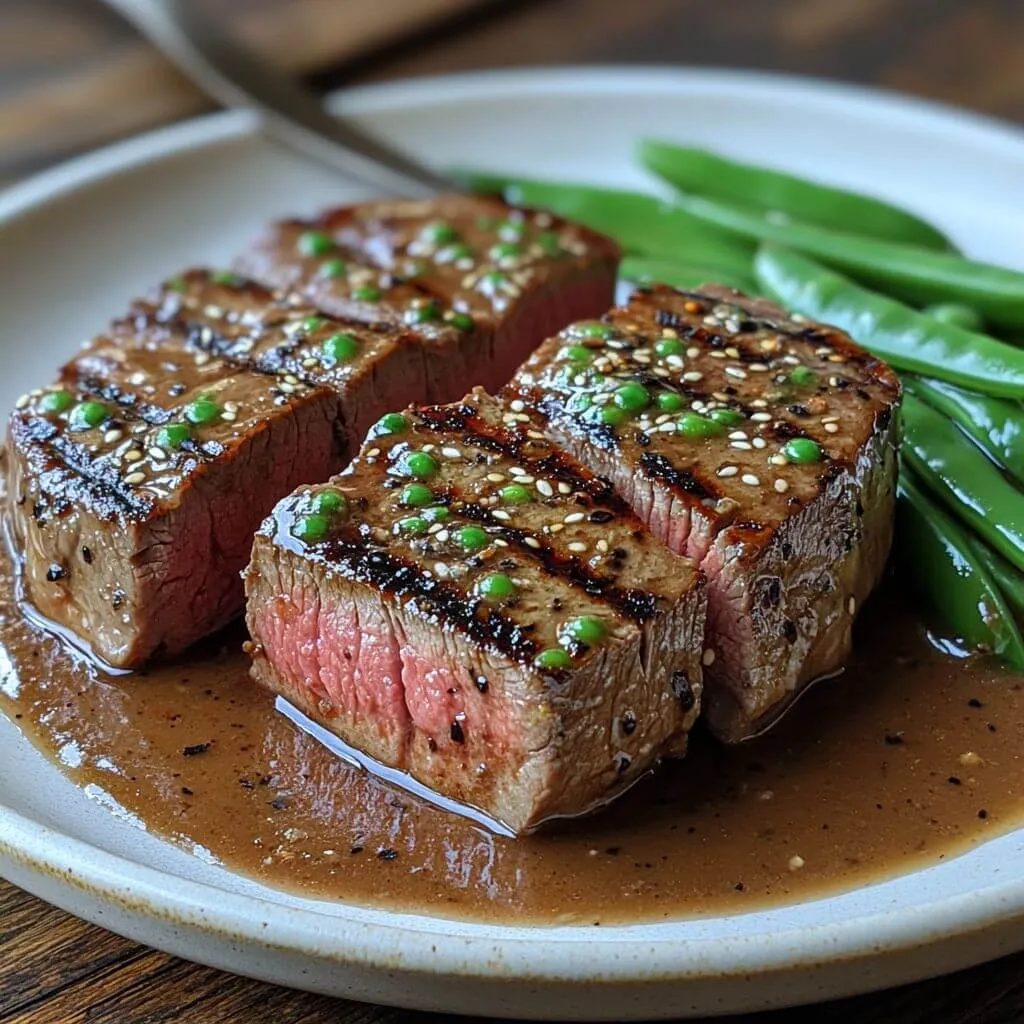Introduction
Bistro beef steak is one of those cuts that quietly steals the spotlight—lean, tender, and packed with a rich, beefy flavor that filet mignon lovers will appreciate, but with a rustic edge that feels right at home on a weeknight dinner table.
Hi, I’m Maddie Russo, your go-to home chef here at Freshness Recipes, where I believe in cooking meals that feel both cozy and a little bit inspired. Out here in the Blue Ridge Mountains, my kitchen is where stories simmer and steaks sizzle.
In this guide, I’ll show you exactly how to cook bistro beef steak to perfection—whether you’re grilling, pan-searing, or roasting. You’ll learn how to choose the right cut, season it like a pro, and cook it to juicy, medium-rare glory. Along the way, I’ll share the tips I’ve learned from years of home cooking (and a few steak night mistakes).
Discover great ideas like our beef kaldereta recipe if you’re hungry for more comforting, beefy meals.
Let’s get into it—and bring this butcher’s best-kept secret to your plate.
Understanding the Bistro Beef Steak Cut
What is Bistro Beef Steak?
The bistro beef steak—also known as the bistro filet, shoulder tender, teres major, or petite tender—is a slender, tube-shaped muscle nestled within the chuck (shoulder) primal of the cow. Though lesser-known, it mirrors the tenderness of the coveted filet mignon but with a more robust beef flavor. It’s lean, fine-grained, and exceptionally versatile, making it a favorite among butchers and chefs alike.
This cut is known for being:
- Lean but juicy when cooked correctly
- Tender enough to rival higher-priced cuts
- Flavorful due to its location near more worked muscles
- Versatile, perfect for grilling, searing, or broiling
It’s no wonder this butcher’s secret has made its way into gourmet kitchens and steak-loving households.

Bistro-Style Beef Steak with Garlic Herb Butter
Equipment
- cast-iron skillet
- mixing bowl
- tongs
- paper towels
- serving plate
Ingredients
- 2 beef steaks (ribeye or sirloin)
- 2 tbsp olive oil
- 1 tsp sea salt
- 0.5 tsp black pepper
- 3 tbsp unsalted butter, softened
- 1 clove garlic, minced
- 1 tbsp chopped fresh parsley
- lemon zest (optional)
Instructions
- Take the steaks out of the fridge 30 minutes before cooking to bring them to room temperature.
- In a small bowl, mix softened butter with minced garlic, chopped parsley, and lemon zest if using. Set aside.
- Pat the steaks dry with paper towels. Season both sides with salt and black pepper.
- Heat olive oil in a cast iron skillet over high heat until shimmering. Sear the steaks for 3-4 minutes per side for medium-rare, or to desired doneness.
- Remove steaks from heat and let them rest for 5 minutes. Top each steak with a spoonful of garlic herb butter before serving.
Notes
Nutrition
Shoulder Tender Explained: The Butcher’s Hidden Gem
Often overshadowed by ribeyes or tenderloins, the shoulder tender (teres major) is one of the most underrated premium cuts. Located underneath the shoulder blade, it’s a muscle that doesn’t bear much weight, which explains its impressive tenderness.
It has been gaining traction under several names:
- Bistro Steak
- Bistro Filet
- Shoulder Tender
- Petite Tender
What sets it apart?
| Feature | Shoulder Tender (Bistro Steak) |
|---|---|
| Source | Chuck primal (shoulder area) |
| Texture | Fine-grained, like tenderloin |
| Flavor | Richer than filet mignon |
| Cooking Methods | Grilling, searing, sous vide, broiling |
Because of its lean profile and low fat content, it’s best cooked rare to medium. Overcooking can dry it out—so keep a meat thermometer handy.
Looking for inspiration? Try our steak and rice bowl recipe for a perfect combo using tender steak cuts.
Bistro Beef Steak vs Other Steak Cuts
Bistro Steak vs Filet Mignon
If you’ve ever tried filet mignon, you know it’s prized for being ultra-tender, buttery, and lean. But bistro beef steak—sometimes called bistro filet or shoulder tender—offers a compelling alternative for those looking for a little more character.
While filet mignon comes from the tenderloin and is known for its melt-in-your-mouth texture, bistro steak hails from the shoulder (or chuck) region, specifically the teres major muscle. It’s less expensive, slightly firmer in texture, but rich in flavor.
Here’s a quick side-by-side breakdown:
| Feature | Bistro Beef Steak | Filet Mignon |
|---|---|---|
| Cut Location | Shoulder (Chuck) | Tenderloin (Loin) |
| Tenderness | Very tender | Extremely tender |
| Flavor | Beefier, more robust | Milder, buttery |
| Fat Content | Lean | Very lean |
| Price | More affordable | Premium |
| Best Cooking Method | Grill, sear, sous vide | Pan-sear, roast |
Why choose bistro steak? It gives you steakhouse-level results with a more affordable price tag, and its slightly firmer bite holds up beautifully to bold seasonings and high-heat cooking methods.
Comparing Flavor and Texture with Other Chuck Cuts
The chuck primal is usually associated with tougher, braising-friendly cuts like chuck roast or flat iron steak. So, how does the bistro steak manage to be so tender?
It all comes down to the muscle: the teres major doesn’t get much action, which means it stays fine-grained and tender, even though it’s technically a shoulder cut. It’s as lean as a sirloin yet packs more punch than a tenderloin.
Let’s compare it with a few chuck neighbors:
| Cut | Tenderness | Flavor Profile | Best Use |
|---|---|---|---|
| Bistro Steak | Very tender | Beefy, lean | Grilled, Seared |
| Flat Iron | Moderately tender | Juicy, marbled | Grilled, Stir-fried |
| Chuck Eye Steak | Less tender | Rich, fatty | Braised, Slow-cooked |
| Chuck Roast | Tough | Deep, beefy | Stews, Pot roast |
Check out our steak and rice bowl recipe for another way to use flavorful but affordable cuts like bistro steak.
In short? Bistro beef steak is the unicorn of chuck cuts: tender enough for grilling, bold enough for serious steak fans.
Choosing the Best Bistro Beef Steak for Cooking
What to Look for in a Quality Bistro Beef Steak
Choosing the right bistro beef steak is the first step toward a tender, flavorful meal. This cut may be naturally lean and soft, but selecting a high-quality one can make the difference between a decent dinner and an unforgettable one.
Here’s what to watch for when buying your bistro steak:
- Even Thickness: Even cuts—about 1 to 1½ inches thick—help the steak cook evenly all the way through.
- Vibrant Red Color: Fresh bistro beef steak should have a deep red hue with minimal browning.
- Smooth Texture: Look for a fine, tight grain. Cut from the shoulder tender, this steak is prized for its naturally soft texture.
- Little to No Silver Skin: Trimmed cuts are best. Too much silver skin can make the steak chewy, especially when searing or grilling.
Many stores label bistro beef steak under different names. Be on the lookout for:
- Shoulder Tender
- Bistro Filet
- Petite Tender
- Teres Major Steak
No matter the name, the key is ensuring the cut looks fresh and feels firm to the touch.
How to Source Fresh and Tender Bistro Steaks
Because it’s a butcher’s favorite and not always mass-marketed, the bistro beef steak might not appear on every shelf. But don’t worry—there are plenty of ways to source this incredible cut.
- Local Butcher Shops: Ask directly for bistro beef steak or its common names like shoulder tender or teres major. Butchers often have it behind the counter.
- Premium Grocery Stores: Some upscale supermarkets or farm markets stock bistro steak under specialty meat sections.
- Online Retailers: Many reputable meat suppliers offer bistro beef steaks delivered to your door, often trimmed and ready to cook.
- Farm Subscriptions or Meat Boxes: Joining a CSA or curated meat box club can give you access to high-quality, lesser-known cuts like bistro filet.
Check out our grilled steak and rice bowl recipe for a creative way to use this tender cut in a bold, satisfying meal.
When shopping, look for these signs of quality:
- Pasture-raised or grass-fed options for better flavor and ethics
- USDA Choice or Prime grade for natural marbling
- Wet-aged beef, which is ideal for enhancing tenderness in lean cuts like bistro beef steak
Finding the right bistro steak may take a little effort, but once you taste it—juicy, tender, and full of deep beef flavor—you’ll know it was worth the search.
Preparing Bistro Beef Steak for Cooking
How to Properly Thaw and Temper Bistro Beef Steak
Before the sizzle hits the skillet or the steak kisses the grill, your bistro beef steak needs proper prep. One of the biggest mistakes home cooks make with this lean, tender cut is cooking it straight from the fridge—or worse, while still frozen.
Follow these simple steps to ensure your steak is prepped for perfection:
- Thaw Gently in the Fridge
Always thaw your bistro steak in the refrigerator for 24 hours. This slow thaw helps preserve its natural juices and texture. - Bring to Room Temperature
Take the thawed steak out 30–40 minutes before cooking. Letting it rest on the counter helps it cook more evenly, preventing a cold center and overdone edges. - Pat it Dry
Use paper towels to remove surface moisture. A dry steak creates better caramelization, giving you that rich, golden-brown crust. - Trim if Needed
Some bistro beef steaks come pre-trimmed, but if you notice excess silver skin or tough bits, use a sharp knife to remove them.
Seasoning Techniques for Maximum Flavor
The natural beefy depth of bistro beef steak shines with minimal seasoning, but don’t be afraid to enhance it with bold layers of flavor. Since it’s a lean cut, it benefits from seasonings and fats that boost richness.
Basic Bistro Steak Seasoning
Stick to the classics:
- Kosher Salt
- Freshly Cracked Black Pepper
- Garlic Powder or Smoked Paprika (optional)
Rub the seasoning generously on all sides. Let it sit for 10–15 minutes to penetrate the surface.
Marinades: Yay or Nay?
While marinating isn’t required for this tender cut, it can add extra character. If you go this route, keep it short—no more than 30–60 minutes. A simple blend of olive oil, soy sauce, lemon juice, and herbs gently enhances your bistro steak—tenderizing it, locking in moisture, and adding flavor without taking over.
Flavor-Boosting Add-Ons
- Bacon Wrap: A strip of bacon around each steak not only looks impressive—it adds smoky richness while protecting the lean meat from drying out.
- Compound Butter: Try a garlic-herb or blue cheese butter. Add a pat just before serving to melt over the hot steak.
Don’t miss our garlic parmesan cheeseburger bombs for another flavor-packed beef idea you can prep with bold seasoning blends.
Prepping Recap Table
| Step | Why It Matters |
|---|---|
| Thaw in the fridge | Preserves texture and flavor |
| Temper before cooking | Ensures even doneness |
| Pat dry | Promotes better sear |
| Season well | Enhances natural beef flavor |
| Optional bacon wrap | Adds fat and prevents dryness |
When your bistro beef steak is thawed, seasoned, and ready to go, all that’s left is choosing your favorite cooking method.
How to Cook Bistro Beef Steak on the Grill
Charcoal Grilling Method
Grilling bistro beef steak over charcoal gives it a rich, smoky flavor that pairs perfectly with its bold, beefy profile. Here’s how to get that steakhouse crust at home:
- Set Up Your Grill: Push most hot coals to one side for high heat, leaving the other side cooler for indirect cooking.
- Sear First: Grill your bistro steak over high heat, searing each side for 1–2 minutes to build a flavorful crust and seal in moisture.
- Finish Indirectly: Move the steak to the cooler side and cook to your desired doneness, flipping once.
Cooking Time Chart (Charcoal)
| Thickness | Doneness | Grill Time | Internal Temp |
|---|---|---|---|
| 1 inch | Medium-Rare | 7–8 mins total | 130°F |
| 1½ inch | Medium-Rare | 9–11 mins total | 130°F |

👉 For perfect doneness, trust a meat thermometer—not guesswork.
FOLLOW ME on FACEBOOK, INSTAGRAM and PINTEREST for more great recipes!
Gas Grilling Instructions
Prefer a gas grill? The steps are just as easy:
- Preheat on High: Get the grill hot—like sizzling-hot.
- Sear for Flavor: Place the bistro beef steak on the grill and sear each side for 1–2 minutes.
- Lower the Heat: Turn the burner to medium and finish cooking, flipping once around the halfway mark.
Gas Grill Quick Tips:
- Use the lid to retain heat during the finishing stage.
- Let it rest 5 minutes—so the juices stay in, not on your cutting board. This prevents losing flavorful juices.
Don’t miss our street corn chicken rice bowl if you’re looking for a great side to complement grilled meats.
Final Touches for Grilled Bistro Steak
- Add a dollop of finishing butter right after grilling.
- Rest under foil for 5 minutes—carryover heat will bring it to a perfect 135°F for medium-rare.
- Always slice across the grain—it’s the secret to a tender, juicy bite.
Grilled right, bistro beef steak delivers big flavor with steakhouse quality—without the price tag or the fuss.
How to Cook Bistro Beef Steak on the Stove
Pan-Searing for Golden Perfection
No grill? No problem. Cooking bistro beef steak on the stove gives you that rich sear and caramelized crust using just a hot pan and a bit of patience.
Here’s how to do it right:
- Preheat Your Skillet
Use a heavy, non-stick or cast iron pan. Let it heat over medium-high for 5 minutes—yes, a full five. A hot pan is key to a proper sear. - No Oil Needed
If your bistro beef steak is wrapped in bacon (a great trick for flavor and moisture), don’t add oil. The bacon fat will render into the pan as it cooks. - Sear Both Sides
Place the steak in the hot pan and sear for:- 7–8 minutes total for a 1-inch steak
- 9–11 minutes total for a 1½-inch steak
Flip once, about 1 minute before the halfway mark.
- Check the Temperature
For medium-rare, use a meat thermometer. Remove from heat when it hits 130°F, and let it rest—it will rise to 135°F as it sits.
Resting is Non-Negotiable
After cooking, loosely cover your steak with foil and let it rest for 5 minutes. This allows juices to redistribute, keeping your bistro steak moist and flavorful.
Don’t miss our chicken burrito bowl in rice cooker—another quick stovetop favorite for your weekday dinner lineup.
Flavor Boost Ideas
While a well-seared bistro beef steak stands beautifully on its own, try adding:
- A pat of garlic herb butter right after searing
- A splash of balsamic glaze or red wine pan sauce for depth
- Serve with roasted veggies or creamy mashed potatoes for a comforting finish.
Cooking bistro beef steak on the stove is perfect for weeknights or rainy days—and when done right, it’s every bit as satisfying as grilled.
Specialty Methods – Broiling and Sous Vide
Sous Vide for Precision Cooking
Sous vide is one of the easiest ways to make bistro beef steak incredibly tender.
- Season, then vacuum-seal with herbs or a pat of butter for extra flavor.
- Set the water bath to 129°F for medium-rare.
- Cook for 1.5 to 2 hours, then quickly sear each side in a hot skillet.
This method locks in flavor and ensures a perfect cook from edge to center—ideal for lean cuts like bistro steak.
Quick and Easy Oven Broiling
If you prefer oven cooking, broiling is a great high-heat option:
- Preheat your broiler and place the steak on a pan about 6 inches from the heat.
- Broil for 4–6 minutes per side, flipping once.
- Rest the steak for 5 minutes before slicing.
Looking for inspiration? Try our loaded taco fries recipe for a bold and crispy side.
Both methods are simple, indoor-friendly ways to enjoy bistro beef steak with a rich crust and juicy center—no grill required.
Serving and Presentation Tips
Resting Matters: Keep It Juicy
Once your bistro beef steak is cooked to perfection, don’t slice it right away. Rest it under foil for 5 minutes. This gives the juices time to redistribute, so they don’t end up on your cutting board instead of in your steak.
During rest, the internal temp rises slightly (about 5°F), finishing the steak naturally—a process called carryover cooking. For perfect medium-rare, rest until the steak hits 135°F.
Finishing Touches That Elevate
Add flavor and polish your presentation with simple but effective touches:
- Compound Butter: Garlic herb, blue cheese, or truffle butter add instant richness.
- Fresh Herbs: A sprinkle of thyme or rosemary adds aroma and color.
Slice the bistro steak against the grain to enhance tenderness, and use a sharp knife for clean cuts.
Perfect Pairings
Make your plate complete with easy, flavorful sides:
| Side Dish | Why It Works |
|---|---|
| Roasted Garlic Mashed Potatoes | Creamy base to balance the beefiness |
| Sautéed Green Beans | Adds color and crunch |
| Balsamic Glazed Carrots | Sweet-savory contrast |
| Crusty Bread | Great for soaking up juices |
Check out our garlic parmesan chicken pasta for a comforting side idea you can serve family-style.
With just a few thoughtful details, your bistro beef steak goes from weekday dinner to steakhouse showpiece—no reservations required.

Bistro Steak Recipes and Meal Ideas
Simple Bistro Beef Steak Dinner Ideas
Once you’ve mastered the basics, it’s time to turn your bistro beef steak into unforgettable meals. This cut’s rich flavor and tenderness make it perfect for both casual dinners and special occasions.
Here are some easy, delicious ways to serve it:
- Bistro Steak with Garlic Mashed Potatoes
A classic combo. Add pan-seared mushrooms or a red wine reduction for a gourmet touch. - Bistro Steak Tacos
Slice thin against the grain, then layer into warm tortillas with pickled onions, avocado, and a squeeze of lime crema. - Bistro Steak Salad Bowl
Serve sliced steak over greens with cherry tomatoes, blue cheese, and a balsamic vinaigrette. - Steak and Eggs
Perfect for brunch—pair with crispy hash browns and sunny-side-up eggs. - Open-Faced Steak Sandwich
Pile warm bistro steak, sweet caramelized onions, and gooey provolone onto toasted crusty bread.
Creative Marinade and Flavor Variations
The bold flavor of bistro beef steak pairs beautifully with different seasonings and sauces:
- Asian-Inspired: Soy sauce, ginger, sesame oil marinade
- Chimichurri Sauce: Fresh herbs, garlic, vinegar, and olive oil
- Coffee Rub: A mix of ground coffee, brown sugar, and smoked paprika
- Balsamic Reduction: Sweet and tangy, perfect for drizzling
Don’t miss our steak sandwich recipe for another tasty way to repurpose leftovers into something amazing.
Batch Cooking Tips
Got more than one steak? Cook in bulk and use leftovers in:
- Stir-fries
- Wraps
- Grain bowls
- Pasta dishes
Bistro beef steak holds up well in the fridge for 3–4 days, making it ideal for meal prep.
From elegant plates to weeknight wonders, this versatile cut keeps your dinner game strong.
FAQs About Bistro Beef Steak
What cut of beef is a bistro steak?
Bistro beef steak comes from the teres major muscle, located in the chuck (shoulder) primal of the cow. Despite being from the shoulder area, this cut is incredibly tender and lean, often compared to filet mignon. It’s sometimes labeled as shoulder tender, bistro filet, or petite tender.
What is the best way to cook a bistro steak?
The best way to cook bistro beef steak is to sear or grill it to medium-rare. Due to its leanness, overcooking can cause dryness. Pan-searing, charcoal grilling, or sous vide followed by a quick sear are excellent options. Always let the steak rest before slicing to retain its juices.
Are bistro steaks tender?
Yes! Despite its origin from the shoulder, bistro beef steak is one of the most tender cuts available. It’s second only to tenderloin in softness and has a fine-grain texture that’s perfect for quick, high-heat cooking. Just be sure not to overcook it.
What is another name for a bistro steak?
Bistro beef steak is known by several names:
Shoulder Tender
Teres Major
Bistro Filet
Petite Tender
All these refer to the same underappreciated but delicious cut that offers tenderness, flavor, and affordability.
Conclusion: Bring Bistro Beef Steak to Your Table with Confidence
Whether you’re grilling outdoors, pan-searing on the stove, or experimenting with sous vide, bistro beef steak is a flavorful, tender cut that deserves a spot in your dinner rotation. Its lean profile, fine texture, and deep beefy flavor make it a standout choice for steak lovers who want gourmet results without the premium price tag.
From choosing the right cut to seasoning, cooking, and serving, this guide has given you the tools to turn a humble bistro steak into something truly special. Remember to cook it to medium-rare, let it rest, and slice it against the grain—and you’ll impress every time.
Looking for inspiration? Try our best steak sandwich recipe for an easy way to use leftovers the next day.
Thanks for stopping by my kitchen here at Freshness Recipes. Whether it’s your first bistro steak or your tenth, I hope you now feel empowered to cook with flavor, confidence, and heart.
Let’s keep cooking together—one juicy bite at a time.

